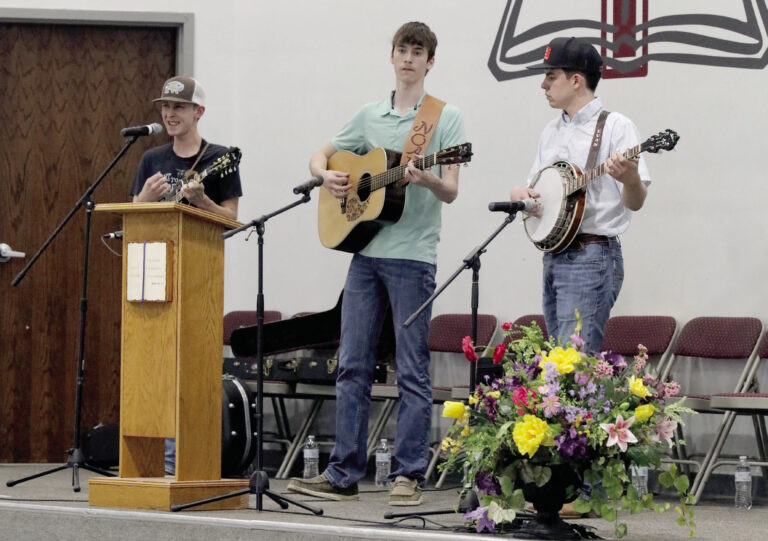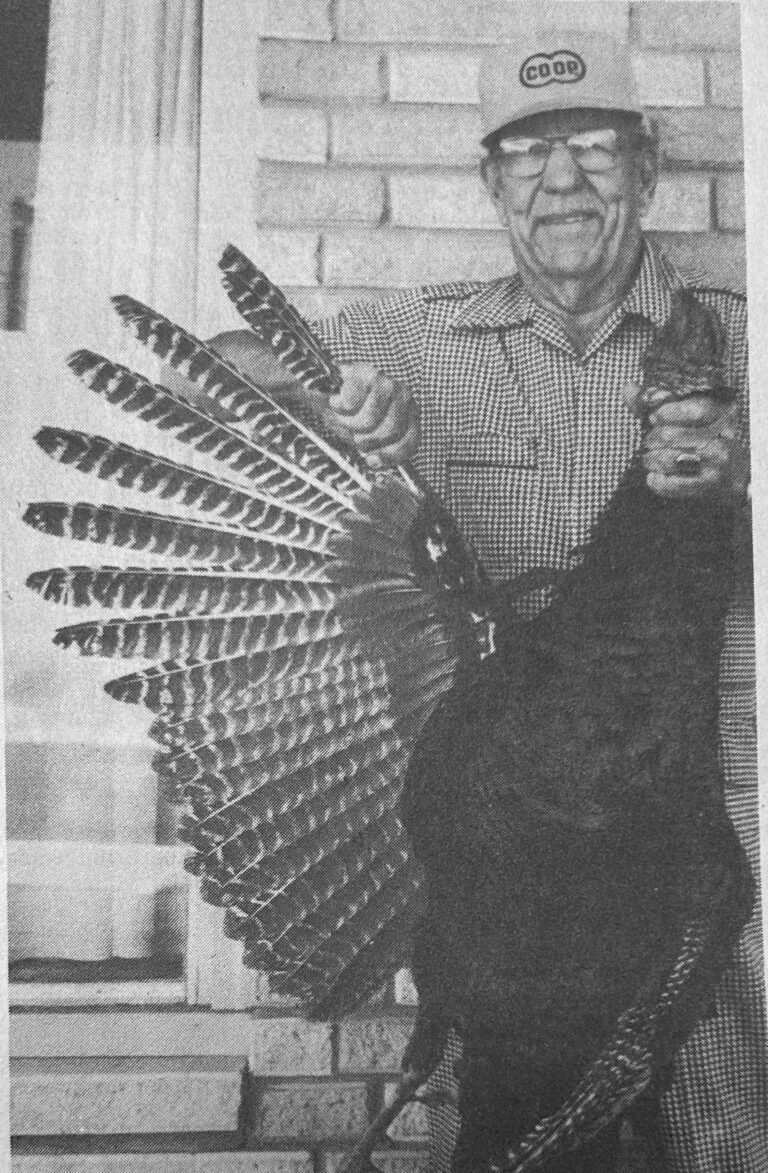50 years ago
March 13, 1974
— SAYMAN PORTRAIT PRESENTED TO ROARING RIVER
An oil portrait of the late Thomas M. Sayman of St. Louis, benefactor of Roaring River State Park near Cassville was presented to the Missouri State Park Board by his daughter in a ceremony Saturday at the park office. Lady Peter Smithers of Lugano, Switzerland, the former Dojean Sayman Lane, made the presentation to Joe R. Ellis, Cassville attorney and member of the State Park Board. Sayman, multi-millionaire soap manufacturer and philanthropist, donated 2,400 acres in Barry County, including Roaring River Spring, to the state for a park in 1928. The park has since been expanded to 3,459 acres. The portrait was commissioned by his widow, Mrs. Luella Sayman of St. Louis in 1952, and painted by Mrs. Martin (Aimee) Schweig, a St. Louis artist. Mrs. Say-man, a well-known St. Louis civic leader, died February 17 at age 97. She wanted the portrait to be given to the park after her death, according to Lady Smithers. Lady Smithers was accompanied to the park by her son, Army Maj. C. Dennison Lane, and Mrs. Lane. Sayman was born September 25, 1853, in Richmond, Indiana. As a young man he toured with circus impresario P. T. Barnum, and later was involved in vaudeville He studied medicine, and developed a successful soap products company, the T. M. Sayman Products Co., in Carthage. The offices were moved to St. Louis in 1894. Sayman purchased Roaring River from a Kansas City financial institution during a public auction on the Barry County Court House steps. The property had been owned by the Bruner family. Reported purchase price was in excess of $100,000. The late Mr. Sayman also contributed the balcony to the old Cassville city hall building, which is now the Hall Theatre building. An inscription on the front of the balcony was removed several years ago when a remodeling project was completed. There is considerable history behind Mr. Sayman and his visits here. He was considered to be a man with considerable temper. He reportedly carried a pistol with him virtually everywhere he went. Sayman died at his St. Louis home on September 6, 1937, at age 83. His widow managed the company as vice president from 1937 until 1968, when the company was dissolved. Mrs. Sayman was the first woman chairwoman of the St, Louis Salvation Army board of directors and the Pilgrim Congregational Church board. of trustees. She was designated the 1956 Woman of the Year by the St. Louis Chamber of Commerce and in 1962 was named a Commander of the British Empire by Queen Elizabeth lI. Lady Smithers is the wife of Sir Peter Smithers, retired British foreign service officer and former secretary general of the Council of Europe in Strasbourg France.
40 years ago
March 14, 1984
— NEW RESTAURANT OPENS
Patsy Marshall has opened D and K Hilltop Restaurant in the area south of Cassville. The business is located at the intersections of Highway 112- 76-86. Full food service will be featured at the new area eating establishment.
— NEW OWNERS SHELL KNOB AREA RESORT
The 18-unit Hidden Cove Resort at Shell Knob on Table Rock Lake has been sold to Mr. and Mrs. Bob Graham of Bloomington, III. Mr. and Mrs. Jack Fly, who have operated the resort 12 years, will give possession March 24. Formerly in the brokerage business, the Graham family will make their home in a residence connected to one section of the resort. Hidden Cove, developed a number of years ago by Mr. and Mrs. Howard McIllrath, is located on Highway 39 just south of the Central Crossing Bridge over Table Rock. While future plans are not complete, Mr. and Mrs. Fly will move to Aurora. Both have been extensively active in Shell Knob community affairs, especially the volunteer fire department operations. Fly is a past president of the former Central Crossing Association promotional group for the lake recreation area.
30 years ago
March 2, 1994
— GEORGE’S EXPANDING; DELAYS MILL, HATCHERY
With a production and employment expansion in the immediate offing, George’s Poultry Co. will delay plans for building a hatchery and mill at the Butterfield processing plant location. Craig Coberley, plant superintendent, says expansion of company facilities across Route W from the processing plant could be two years away. Coberley explained installations of new systems in the company’s Springdale hatchery would eliminate the immediate need of new hatchery facilities. As the company expands production lines and subsequently adds employment numbers, company officials will reevaluate needs for the 252 acre area immediately south of the 380 acre initial George’s location across Highway 37 from Butterfield. George’s plans for the Butterfield plant, whose location was acquired five years ago, includes adding 120 employees. Current employment at the plant, operating in two shifts, stands at 500. Involved will be a production system change. The superintendent said the process would include switching from a streamline inspection system to a new evisceration system. In this process, productions of three lines will be increased from 70 birds per minute to 90 birds per minute. Included will be putting an additional inspector on each line. Coberley said the company would need more people at each phase of their operations, requiring about 60 more per shift. As production in the plant increases, so will the need for growers in the area. George’s currently has about 100 growers in the area and will require about 100 additional houses when production numbers increase. The house numbers could be divided between 30 new growers or absorbed by existing growers adding houses on their property. Expansion in production and grower numbers will be experienced this year, with the exact timing yet to be established by the Springdale, Ark., company. Under current circumstances, speculation is that many of the house numbers, now raising between 20,000 and 24,000 birds each, will be absorbed by existing producers. Building new houses might well take on a different look for the industry in this area. Five years ago houses were built in the 40’ x400’ dimension classes. They cost $65,000 to $70,000 each depending on equipment. Today’s recommended houses for the growers and company interests are 40’×450’ and cost up to $93,000. Builders, finances and company people say everything from the Spotted Owl, to Hurricane Andrew to California earthquakes have increased building material prices since the late big influx of poultry house construction arrived in Barry County. When line improvements and availability of poultry is complete, George’s plant at Butterfield will advance from one million birds a week to 1.3 million a week. While some buildings have been removed and clearing begun at the latest George’s land acquisition, Coberley is quite sure it will be a couple of years before any actual construction begins. Adjacent to the site is a Northwest Arkansas-Missouri railroad line that would be suitable for supply of a mill for raw materials. Within site of the George’s plant is a Hudson Foods mill north of Butterfield that services this company’s turkey growing farms scattered throughout the area. Coberley said while the Butterfield hatchery and mill plans of George’s are presently at the “not pressing” category, the site purchased in April of 1993 could well fit into additional company plans. Needs might include expansion of a land application waste water system that most of a 380 acre original site provides. George’s Poultry, a family owned company, arrived in Barry County in 1987 in a $10 million investment by the firm in their first facilities in Missouri. President of the 73-year-old company is Gary George. The sprawling plant facilities include over 90,000 square feet, dedicated entirely to processing poultry.
— WEEKDAY OPENING, UNDER RAIN THREAT GOES OVER
2,000 TAGS Falling weather in the area lifted for Roaring River State Park’s opening Tuesday with Mother Nature providing acceptable 35 degree temperatures at the 6:30 a.m. opening gun. In a situation that wasn’t as crowded as in the past, fisherpersons had plenty of water in the stream, it remained clouded following recent rains, and pre-opening stocking of Rainbow Trout seemed to fit most of the anglers’ best expectations. The weekday gathering, hoping to bump a record 2377 set in 1988, obviously was going to be short. None-the-less, anglers were enjoying themselves with plenty of fish and abnormal space to fish. At 5:45 a.m. there had been 1400 tags sold. As of 2:45 p.m. park officials were thinking of cutting off tag sales as mist was falling and an early arrival of darkness was possible. At that time the number had reached 2010, according to Tim Homesley. There was the usual tangling of lines as 1500 were estimated to be streamside when secretary of state Judi Moriarty fired the signal that sent anglers whipping the stream along 1.6 miles in two zones from the hatchery to the old lake dam. Zone three runs from the dam to the park boundary 1.4 miles. In zones one and two, there are 33 pools divided by baffles. Trout fisherpersons, as they are prone to do, chose favorite spots early and didn’t mind that there were elbow-toelbow conditions in those particular areas. That seems to be a part of the spring ritual that comes each March 1. By noontime, temperatures went to 41 degrees, according to hatchery superintendent Jerry Dean. Trout tag sales continued to increase during the day. For instance there were 1842 sold at 8:40 opening morning, indicating about 300 in the area waited to see if the predicted rainfall actually arrived. There was a 70 percent chance of rain in the area during the day according to forecasts. Only fog in the area hampered the anglers on their way to Roaring River valley and the kickoff of the 66th opening of the facility. Stream operations are under the Missouri Conservation Department. Park facilities are operated by Missouri Department of Natural Resources, Division of Parks and Historical Shrines. Jack Nickols, concessionaire for accommodation, store and restaurant facilities, said the opening went extremely smooth. He noted smooth operations in all his departments.







